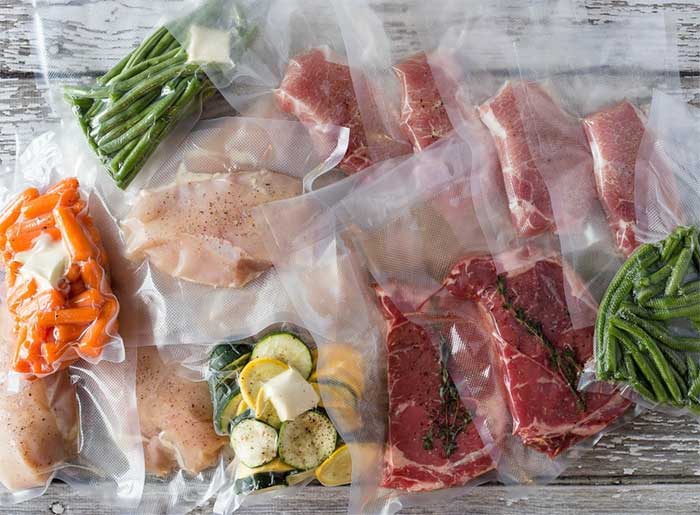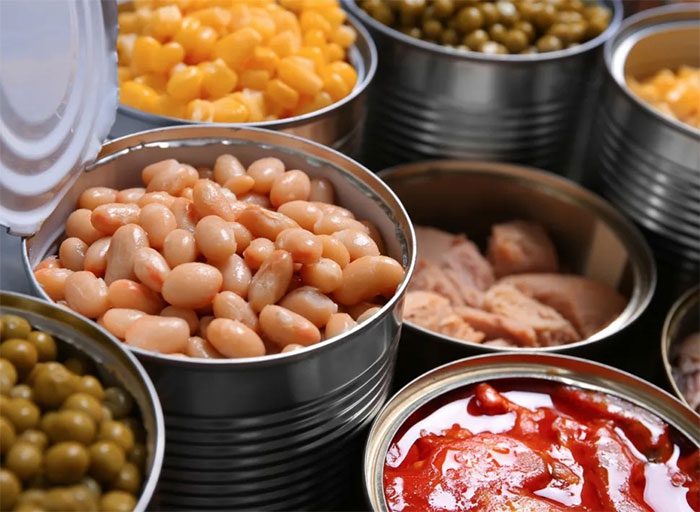According to experts, in environments devoid of oxygen, such as sealed cans and vacuum packaging, Clostridium botulinum can become reactivated, grow, and produce a dangerous toxin.
Vacuum packaging of food or sealed containers for food preservation is common among people today, as it is widely used. In supermarkets, stores, or households, one can easily find vacuum-sealed food packages or airtight containers.

In supermarkets, stores, or households, vacuum-sealed food packages or airtight containers are commonly found. (Image: Ristapackaging).
Conditions Favoring Clostridium Botulinum Reactivation
Associate Professor Dr. Nguyen Duy Thinh, former lecturer at the Institute of Technology and Food, Hanoi University of Science and Technology, stated that vacuum conditions are excellent for preventing oxidation and the attack of mold bacteria, the primary causes of food spoilage. Using vacuum packaging methods when products do not contain Clostridium botulinum is highly beneficial.
Clostridium botulinum is an anaerobic bacterium, unable to survive in oxygen-rich environments or low pH environments. However, when reactivated (in an oxygen-free environment), it releases Botulinum, a neurotoxin, which is the most potent poison known to be lethal.
Botulinum poisoning from food is a public health emergency as many individuals can be poisoned by consuming contaminated food.
Dr. Thinh emphasized that not only canned foods, but also fermented foods stored in jars and foods preserved in vacuum bags also carry the risk of contamination by this toxin if not properly processed.
In agreement, Dr. Le Quoc Hung, head of the Tropical Diseases Department and the Poison Control Unit at Cho Ray Hospital (Ho Chi Minh City), noted that spores of Clostridium botulinum are found all around us, especially in environments with mud, soil, sludge, and animal waste. This bacterium also thrives in protein-rich foods.
The human living environment, which has abundant oxygen, prevents Clostridium botulinum from proliferating. However, in oxygen-free conditions, such as sealed cans or vacuum packaging, they can reactivate, grow, and produce Botulinum toxin.
Boiling Eliminates Most Botulinum Toxin
Associate Professor Dr. Do Van Dung, head of the Public Health Department at Ho Chi Minh City University of Medicine and Pharmacy, stated that all other foods, including vegetables, fruits, seafood, meat, and fish, are at risk of being contaminated with Clostridium botulinum if they are fermented, tightly wrapped, and not safely processed.
Classic symptoms of Botulinum poisoning include double vision, blurred vision, drooping eyelids, slurred speech, difficulty swallowing, dry mouth, and muscle weakness. Children with Botulinum poisoning often appear very fatigued, have poor feeding (or breastfeeding), constipation, weak crying, and reduced muscle tone. All these symptoms indicate muscle paralysis caused by the bacterial toxin. If untreated, these symptoms may progress to respiratory muscle weakness, limb paralysis, and general body paralysis.
In cases of foodborne Botulinum poisoning, symptoms typically begin 18-36 hours after consuming contaminated food, but they can also appear as early as 6 hours or as late as 10 days. If the condition worsens, respiratory muscles are also affected, leading to respiratory failure and death unless respiratory support or mechanical ventilation is provided.

For canned foods, it is advisable to boil the food for about 10 minutes before consumption to ensure safety. (Image: Eatthis).
“Botulinum toxin can be degraded at high temperatures. Boiling eliminates most of this toxin, so well-cooked food is safe from Botulinum. However, many other types of toxins, such as Staphylococcus (staphylococcal bacteria), are not destroyed by heat, thus they can still cause poisoning. Therefore, for canned foods, it is advisable to boil the food for about 10 minutes before eating to ensure safety,” stated Associate Professor Dr. Do Van Dung.
Associate Professor Dr. Nguyen Duy Thinh also emphasized that Botulinum toxin shows no identifiable signs; contaminated food may still appear appetizing, making detection difficult. Therefore, the best way to avoid the risk of contamination is to ensure a thorough and careful processing procedure. If food safety is not ensured, home vacuum sealing or canning can be even more hazardous.
“People need to be cautious about food storage methods to prevent the development of Botulinum toxin; do not seal tightly or create anaerobic environments for long-term food preservation. Additionally, do not consume expired foods or canned goods with bulging or deformed packaging,” advised Dr. Le Quoc Hung.


















































